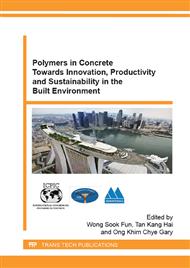p.530
p.538
p.546
p.557
p.565
p.573
p.581
p.586
p.593
Development of Foam One-Part Geopolymers with Enhanced Thermal Insulation Performance and Low Carbon Dioxide Emissions
Abstract:
Buildings are responsible for more than 40% of the energy consumption and greenhouse gas emissions. Thus, increasing building energy efficiency is one the most cost-effective ways to reduce emissions. The use of thermal insulation materials could constitute the most effective way of reducing heat losses in buildings by minimising heat energy needs. These materials have a thermal conductivity factor lower than 0.065 (W/m.K) while other insulation materials such as aerated concrete can go up to 0.11. Current insulation materials are associated with negative impacts in terms of toxicity. Polystyrene, for example contains anti-oxidant additives and ignition retardants. In addition, its production involves the generation of benzene and chlorofluorocarbons. Polyurethane is obtained from isocyanates, which are widely known for their tragic association with the Bhopal disaster. Besides current insulation materials releases toxic fumes when subjected to fire. This paper presents experimental results on one-part geopolymers. It also includes global warming potential assessment and cost analysis. The results show that only the use of aluminium powder allows the production mixtures with a high compressive strength however its high cost means they are commercially useless when facing the competition of commercial cellular concrete. The results also show that one-part geopolymer mixtures based on 26% Ordinary Portland Cement (OPC)+58.3% Fly Ash (FA)+8% Calcined Stuff (CS) +7.7% Calcium Hydroxide (CH) and 3.5% hydrogen peroxide constitute a promising cost efficient (67 euro/m3), thermal insulation solution for floor heating systems with low global warming potential of 443 KgCO2eq/m3.
Info:
Periodical:
Pages:
565-572
Citation:
Online since:
November 2015
Price:
Сopyright:
© 2015 Trans Tech Publications Ltd. All Rights Reserved
Share:
Citation:


